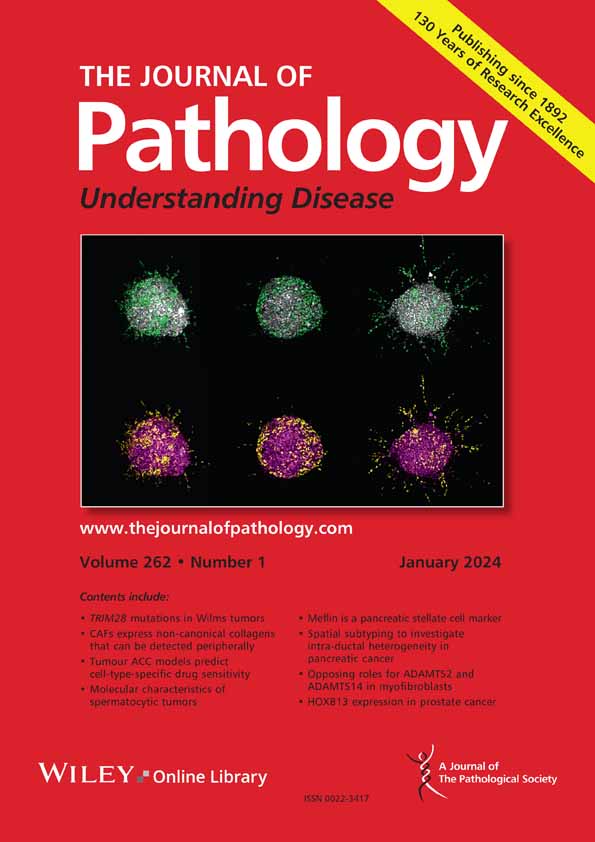Khoa A Nguyen, Lauren E McLemore, Yao Ke, Lisa N DePledge, Lynelle P Smith, Li Bian, John D Aleman, David Debretsion, Erica Wong, Nicole Manning, Xiao-Jing Wang, Christian D Young
下载PDF
{"title":"Activation of PI3K and deletion of p53 in keratin 15-expressing mouse mammary cells induces tumor heterogeneity and plasticity modeling metaplastic breast cancer","authors":"Khoa A Nguyen, Lauren E McLemore, Yao Ke, Lisa N DePledge, Lynelle P Smith, Li Bian, John D Aleman, David Debretsion, Erica Wong, Nicole Manning, Xiao-Jing Wang, Christian D Young","doi":"10.1002/path.6463","DOIUrl":null,"url":null,"abstract":"<p>Although relatively rare, metaplastic breast cancer responds poorly to traditional therapies compared to other subtypes. Accordingly, there is a need for novel animal models to understand its pathogenesis and plasticity. Since alterations in <i>PIK3CA</i> and <i>TP53</i> genes are common in metaplastic breast cancer, we generated a mouse model of metaplastic breast cancer by driving <i>Pik3ca</i> activation and <i>Trp53</i> loss in keratin 15-expressing mammary cells. In this model, male and female mice developed spontaneous mammary lesions, with malignancy reliant on loss of both <i>Trp53</i> alleles. Importantly, tumors of this model are heterogeneous and resemble the mixed histology of metaplastic breast cancer by exhibiting squamous cell carcinoma, carcinosarcoma, and sarcoma features. We developed mammary cell lines from mouse tumors representing these different histological subtypes. These <i>Pik3ca</i>-activated tumor cells were more sensitive to alpelisib, a p110α-selective inhibitor approved by the FDA for the treatment of some <i>PIK3CA</i> mutant cancers, compared to <i>Pik3ca</i> WT cells. Additionally, some of these cell lines expressed the androgen receptor, a hormone receptor targeted in prostate cancer and currently under investigation as a therapeutic target in breast cancer. Transplantation of these cell lines into recipient mice maintained histological heterogeneity. Additionally, transplantation of either Epcam+ or Epcam− sorted cells, representing epithelial cell-like and nonepithelial cell-like, respectively, from a carcinosarcoma cell line, initiated tumor formation. Both sorted populations formed tumors with mixed histologic features, demonstrating plasticity arising from different tumor-initiating components. These new models of metaplastic breast cancer from relevant genetic drivers serve as a platform for identifying mechanisms driving plasticity that could inform therapeutic strategies based on histology and reveal how plasticity alters treatment efficacy. © 2025 The Author(s). <i>The Journal of Pathology</i> published by John Wiley & Sons Ltd on behalf of The Pathological Society of Great Britain and Ireland.</p>","PeriodicalId":232,"journal":{"name":"The Journal of Pathology","volume":"267 2","pages":"213-224"},"PeriodicalIF":5.2000,"publicationDate":"2025-08-13","publicationTypes":"Journal Article","fieldsOfStudy":null,"isOpenAccess":false,"openAccessPdf":"https://www.ncbi.nlm.nih.gov/pmc/articles/PMC12438019/pdf/","citationCount":"0","resultStr":null,"platform":"Semanticscholar","paperid":null,"PeriodicalName":"The Journal of Pathology","FirstCategoryId":"3","ListUrlMain":"https://pathsocjournals.onlinelibrary.wiley.com/doi/10.1002/path.6463","RegionNum":2,"RegionCategory":"医学","ArticlePicture":[],"TitleCN":null,"AbstractTextCN":null,"PMCID":null,"EPubDate":"","PubModel":"","JCR":"Q1","JCRName":"ONCOLOGY","Score":null,"Total":0}
引用次数: 0
引用
批量引用
Abstract
Although relatively rare, metaplastic breast cancer responds poorly to traditional therapies compared to other subtypes. Accordingly, there is a need for novel animal models to understand its pathogenesis and plasticity. Since alterations in PIK3CA and TP53 genes are common in metaplastic breast cancer, we generated a mouse model of metaplastic breast cancer by driving Pik3ca activation and Trp53 loss in keratin 15-expressing mammary cells. In this model, male and female mice developed spontaneous mammary lesions, with malignancy reliant on loss of both Trp53 alleles. Importantly, tumors of this model are heterogeneous and resemble the mixed histology of metaplastic breast cancer by exhibiting squamous cell carcinoma, carcinosarcoma, and sarcoma features. We developed mammary cell lines from mouse tumors representing these different histological subtypes. These Pik3ca -activated tumor cells were more sensitive to alpelisib, a p110α-selective inhibitor approved by the FDA for the treatment of some PIK3CA mutant cancers, compared to Pik3ca WT cells. Additionally, some of these cell lines expressed the androgen receptor, a hormone receptor targeted in prostate cancer and currently under investigation as a therapeutic target in breast cancer. Transplantation of these cell lines into recipient mice maintained histological heterogeneity. Additionally, transplantation of either Epcam+ or Epcam− sorted cells, representing epithelial cell-like and nonepithelial cell-like, respectively, from a carcinosarcoma cell line, initiated tumor formation. Both sorted populations formed tumors with mixed histologic features, demonstrating plasticity arising from different tumor-initiating components. These new models of metaplastic breast cancer from relevant genetic drivers serve as a platform for identifying mechanisms driving plasticity that could inform therapeutic strategies based on histology and reveal how plasticity alters treatment efficacy. © 2025 The Author(s). The Journal of Pathology published by John Wiley & Sons Ltd on behalf of The Pathological Society of Great Britain and Ireland.
在表达角蛋白15的小鼠乳腺细胞中激活PI3K和缺失p53可诱导肿瘤异质性和可塑性模型化乳腺癌。
虽然相对罕见,但与其他亚型相比,转移性乳腺癌对传统疗法的反应较差。因此,需要新的动物模型来了解其发病机制和可塑性。由于PIK3CA和TP53基因的改变在化脓性乳腺癌中很常见,我们通过在表达角蛋白15的乳腺细胞中驱动PIK3CA激活和Trp53缺失,建立了化脓性乳腺癌的小鼠模型。在该模型中,雄性和雌性小鼠发生自发性乳腺病变,恶性肿瘤依赖于Trp53等位基因的缺失。重要的是,该模型的肿瘤是异质的,类似于化生乳腺癌的混合组织学,表现出鳞状细胞癌、癌肉瘤和肉瘤的特征。我们从小鼠肿瘤中培养了乳腺细胞系,代表了这些不同的组织学亚型。与PIK3CA WT细胞相比,这些PIK3CA激活的肿瘤细胞对alpelisib更敏感,alpelisib是一种p110α-选择性抑制剂,已被FDA批准用于治疗一些PIK3CA突变型癌症。此外,这些细胞系中的一些表达雄激素受体,雄激素受体是前列腺癌的一种激素受体,目前正在研究作为乳腺癌的治疗靶点。将这些细胞系移植到受体小鼠体内保持组织学异质性。此外,移植来自癌肉瘤细胞系的Epcam+或Epcam-分类细胞(分别代表上皮样细胞和非上皮样细胞)可启动肿瘤形成。这两个分类的群体形成的肿瘤具有混合的组织学特征,表明不同的肿瘤启动成分产生的可塑性。这些来自相关遗传驱动的新模型为确定驱动可塑性的机制提供了平台,这些机制可以为基于组织学的治疗策略提供信息,并揭示可塑性如何改变治疗效果。©2025作者。《病理学杂志》由John Wiley & Sons Ltd代表大不列颠和爱尔兰病理学会出版。
本文章由计算机程序翻译,如有差异,请以英文原文为准。





 求助内容:
求助内容: 应助结果提醒方式:
应助结果提醒方式:


